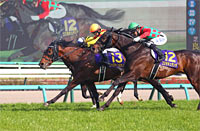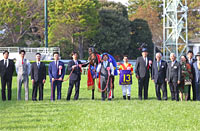Satsuki Sho (Japanese 2000 Guineas) (G1) - Data Analysis
First leg of classic Triple Crown produces historically famous names
There have been 33 winners of the Satsuki Sho since 1984, when the grading system was introduced, and around two-thirds of these (21) have gone on to win other JRA G1 races. Similar statistics for other 3-year-old classics show that 13 winners of the Oka Sho, 11 winners of the Yushun Himba (Japanese Oaks), 11 of the Tokyo Yushun (Japanese Derby), and 17 of the Kikuka Sho (Japanese St. Leger) have gone on to win other JRA G1 races (all as of December 31, 2016). Of all these classic races, then, the Satsuki Sho produces the largest contingent of strong future performers. This time, let’s analyze points shared by successful runners in this race from results over the last 10 years (including 2011, when it was contested on the 2,000m turf course at Tokyo).
Dominance of horses with Top 2 experience in graded races run over 1,800m+
Of 30 Top 3 finishers over the last 10 years, 25 had already experienced a Top 2 finish in “JRA graded races over distances of 1,800m or more.” By contrast, runners without this experience have struggled, achieving a Top 3 ratio of only 6.3%. We should discount horses that have never been close to winning a graded race, or have Top 2 experience only in graded races over distances of less than 1,800m. [Table 1]
[Table 1] Performance by Top 2 experience in JRA graded races over distances of 1,800m or more (last 10 years)
| Top 2 experience |
Performance
[1st-2nd-3rd-4th or lower] |
Win ratio |
Top 2 ratio |
Top 3 ratio |
| Yes |
9-8-8-72 |
9.3% |
17.5% |
25.8% |
| No |
1-2-2-75 |
1.3% |
3.8% |
6.3% |
Moreover, of horses with no prior Top 2 experience in JRA graded races over distances of 1,800m or more, the combined total of those finishing “3rd or lower” and those that “Did not run” in the Wakaba Stakes have only managed a Top 3 ratio of 3.1%. The only runners in these categories to finish in the Top 3 were Captain Thule (2008 winner) and Seiun Wonder (3rd in 2009); all 46 horses without that experience since 2010 have been beaten to 4th or lower. Of runners with no Top 2 experience in JRA graded races over distances of 1,800m or more, our expectations should be even lower if they finished outside the Top 2 in the Wakaba Stakes. [Table 2]
[Table 2] Performance of runners with no Top 2 experience in JRA graded races over distances of 1,800m or more, by finish in the Wakaba Stakes (last 10 years)
| Finish in the Wakaba Stakes |
Performance
[1st-2nd-3rd-4th or lower] |
Win ratio |
Top 2 ratio |
Top 3 ratio |
| In the Top 2 |
0-2-1-13 |
0% |
12.5% |
18.8% |
| 3rd or lower + Did not run |
1-0-1-62 |
1.6% |
1.6% |
3.1% |
Look for a strong performance last time out
Of 30 Top 3 finishers over the last 10 years, 23 had finished “In the Top 2” in their previous outing. Conversely, those finishing “3rd or lower” last time out have failed to impress, achieving a Top 3 ratio of only 8.9%. When comparing performances in the previous race, we should have our eyes firmly on the stronger finishers. [Table 3]
[Table 3] Performance by finish last time out (last 10 years)
| Finish last time out |
Performance
[1st-2nd-3rd-4th or lower] |
Win ratio |
Top 2 ratio |
Top 3 ratio |
| In the Top 2 |
9-7-7-75 |
9.2% |
16.3% |
23.5% |
| 3rd or lower |
1-3-3-72 |
1.3% |
5.1% |
8.9% |
In fact, runners finishing “3rd or lower” in the previous race when it was not the “Yayoi Sho” have failed to win this race, and their Top 3 ratio is also only 3.7%. The conclusion should be that horses beaten to 3rd or lower in their previous race are likely to struggle here when that race was anything other than the Yayoi Sho. [Table 4]
[Table 4] Performance by previous race for horses finishing "3rd or lower" in that race (last 10 years)
| Previous race |
Performance
[1st-2nd-3rd-4th or lower] |
Win ratio |
Top 2 ratio |
Top 3 ratio |
| Yayoi Sho |
1-2-2-20 |
4.0% |
12.0% |
20.0% |
| Other races |
0-1-1-52 |
0% |
1.9% |
3.7% |
Focus on runners backed as 1st favorite last time out
Of 30 Top 3 finishers over the last 10 years, 19 were supported as “1st favorite” in their previous outing. Horses in this category have amassed very strong success ratios, including a Top 3 ratio of 46.3%. We should be looking for runners backed as 1st favorite in their most recent race, regardless of the type of race. [Table 5]
[Table 5] Performance by favoritism last time out (last 10 years)
| Favoritism last time out |
Performance
[1st-2nd-3rd-4th or lower] |
Win ratio |
Top 2 ratio |
Top 3 ratio |
| 1st favorite |
7-6-6-22 |
17.1% |
31.7% |
46.3% |
| 2nd favorite or lower |
3-4-4-125 |
2.2% |
5.1% |
8.1% |
Poor showing by runners with six or more career starts
Of 30 Top 3 finishers over the last 10 years, 23 had previously racked up “5 or fewer” career starts. Conversely, those with “6 or more” starts have had a harder time, with a Top 3 ratio of only 9.9%. We should have lower expectations of horses with greater race experience. [Table 6]
[Table 6] Performance by total career starts (last 10 years)
| Career starts |
Performance
[1st-2nd-3rd-4th or lower] |
Win ratio |
Top 2 ratio |
Top 3 ratio |
| 5 or fewer |
7-8-8-83 |
6.6% |
14.2% |
21.7% |
| 6 or more |
3-2-2-64 |
4.2% |
7.0% |
9.9% |
Affinity with jockey also important
Of 30 Top 3 finishers over the last 10 years, 24 already had “Experience of winning a JRA race with the same jockey as this time.” Horses without this experience have only managed a Top 3 ratio of 6.8%. When checking the runners’ race records, we should be sure to look at their performance in races contested with the same jockey as this time. [Table 7]
[Table 7] Performance by experience of winning a JRA race with the same jockey as this time (last 10 years)
| Experience of winning |
Performance
[1st-2nd-3rd-4th or lower] |
Win ratio |
Top 2 ratio |
Top 3 ratio |
| Yes |
7-9-8-65 |
7.9% |
18.0% |
27.0% |
| No |
3-1-2-82 |
3.4% |
4.5% |
6.8% |
Seek out the winner!
Horses from Kyodo Tsushin Hai and Spring Stakes performing well in recent years
All of the last 6 winners had most recently contested the “Kyodo News Service Hai (G3)” or the “Fuji TV Sho Spring Stakes (G2)” and had finished 1st or 2nd in that race. The last winner coming straight from the Yayoi Sho was Victoire Pisa in 2010, the last one from the Wakaba Stakes was Victory in 2007, and the last winner coming from a 3rd or lower finish last time out was Captain Thule in 2008. As can be seen from the trends in Tables 1 and 3, our attention in this race should be on horses with Top 2 experience in middle-distance graded races and those finishing in the Top 2 last time out. Judging by trends in recent years, however, runners with good performances in the Kyodo News Service Hai or the Fuji TV Sho Spring Stakes should be rated particularly highly. [Table 8]
[Table 8] Winners' "Previous race," "Finish in previous race," and "Highest finish in JRA graded races over distances of 1,800m or more" (last 6 years)
| Year |
Winning horse |
Previous race |
Finish in previous race |
Highest finish in JRA graded races over 1,800m or more |
| 2011 |
Orfevre |
Fuji TV Sho Spring Stakes |
1st |
1st (Fuji TV Sho Spring Stakes) |
| 2012 |
Gold Ship |
Kyodo News Service Hai |
1st |
1st (Kyodo News Service Hai) |
| 2013 |
Logotype |
Fuji TV Sho Spring Stakes |
1st |
1st (Fuji TV Sho Spring Stakes) |
| 2014 |
Isla Bonita |
Kyodo News Service Hai |
1st |
1st (Kyodo News Service Hai, etc.) |
| 2015 |
Duramente |
Kyodo News Service Hai |
2nd |
2nd (Kyodo News Service Hai) |
| 2016 |
Dee Majesty |
Kyodo News Service Hai |
1st |
1st (Kyodo News Service Hai) |
(Masaya Ibuki)
|




















